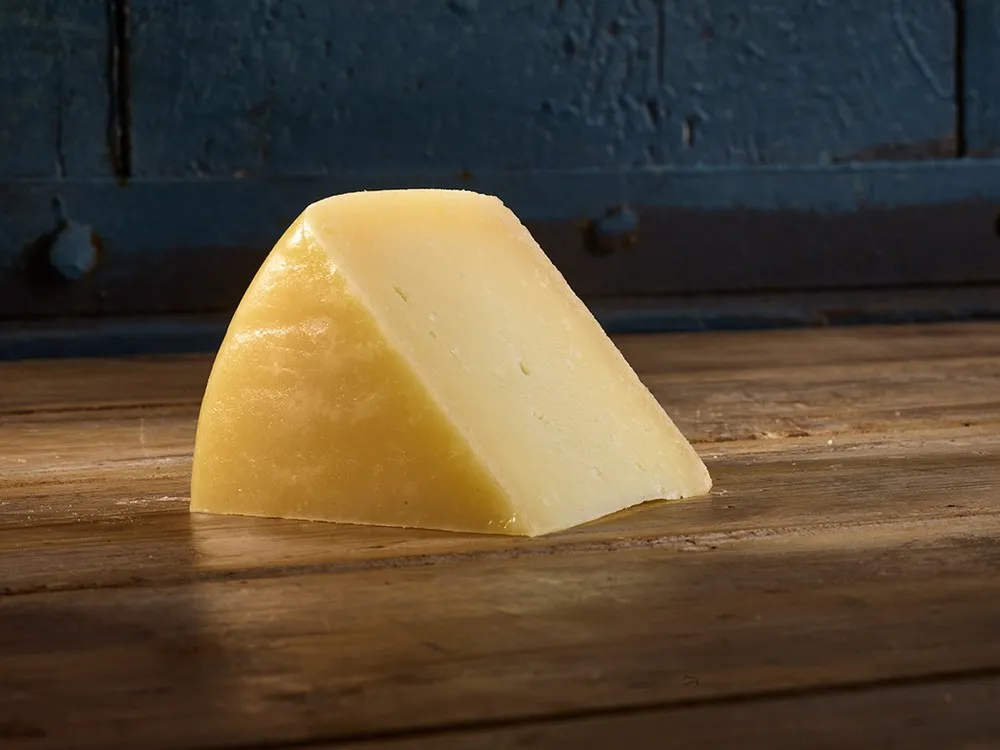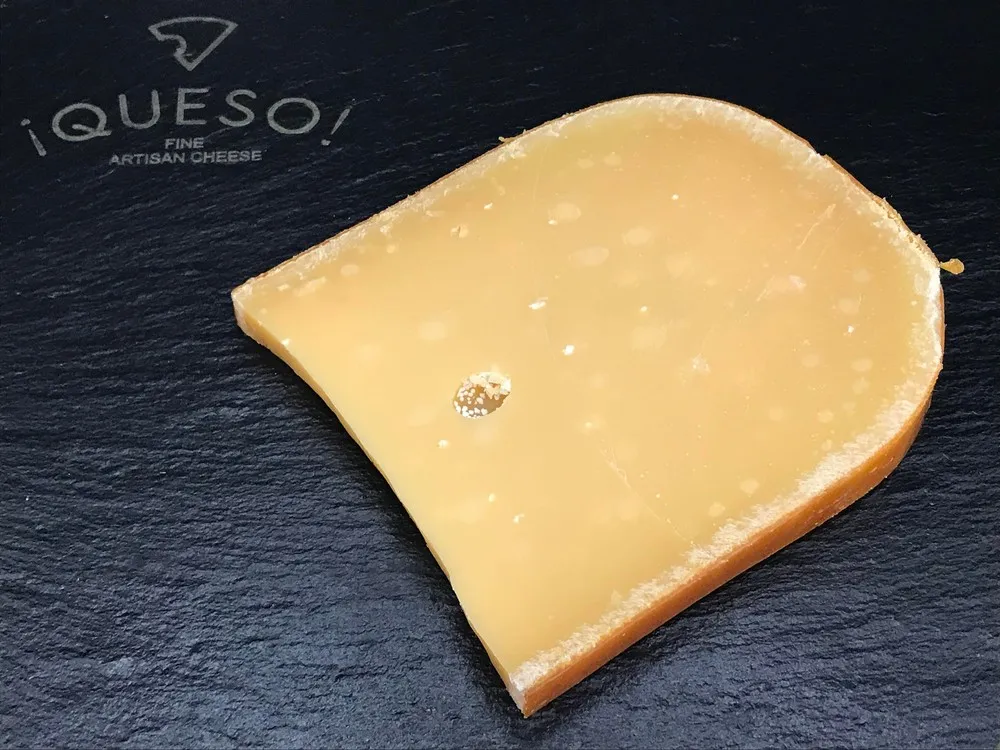Pecorino
What is Pecorino Cheese? What Does Pecorino Taste Like?
Pecorino cheese is an Italian cheese made from sheep's milk, particularly the milk of the Sardinian breed of sheep known as "Pecora" in Italian, from which it gets its name. There are several types of Pecorino cheese, each with unique characteristics, but they all share a distinctive, tangy flavor and a crumbly texture. Pecorino cheese is known for its versatility and is often grated, shaved, or simply eaten on its own. It pairs well with any number of Italian wines. The characteristics of Pecorino cheese frequently vary depending on the regional topography, the length of the aging period, and the specific cheese-making techniques used.
Popular varieties of Pecorino cheese that have Protected Designation of Origin (PDO) status include:
- Pecorino Toscanello: This cheese comes from Tuscany and has a milder, sweeter flavor than its Roman and Sardinian counterparts. It is a hard cheese often used used in salads, sandwiches, or as part of a cheese platter.
- Pecorino Romano: This is a hard and salty cheese originating from the region of Lazio, Sardinia, and parts of Tuscany. Pecorino Romano is known for its sharp and robust flavor.
- Pecorino Fiore Sardo: Hailing from the island of Sardinia, Pecorino Sardo has a more subtle, nutty flavor than Pecorino Romano. It is aged for several months and is a versatile cheese that finds use in dozens of dishes.
What Does Pecorino Cheese Taste Like?
Pecorino cheese has a unique and robust flavor that sets it apart from other types of cheese. It has a tangy, saline feel with slight nutty undertones and a distinct freshness. The flavor intensifies as the cheese matures, developing a sharper and more complex profile. The aging process also contributes to an increasingly firm yet crumbly texture that adds to the overall experience of eating Pecorino.
Thanks to its robust taste, Pecorino is a versatile ingredient that finds use in various Italian recipes. Its bold flavor elevates the taste of pasta dishes, risotto, salads, and even desserts. When combined with the right ingredients, Pecorino has the potential to transform dishes, offering a delightful dining experience.
Pecorino Romano, – the most widespread variety of Pecorino –is known for its sharp, intense flavor.
Hailing from the regions of Lazio and Sardinia in Italy, and is a favorite choice for grating over pasta dishes such as cacio e pepe or carbonara. The salty notes in Pecorino Romano also make it a great addition to cheese boards, offering a savory contrast to sweeter accompaniments like figs or honey.
Another well-known variety is Pecorino Toscanello, which comes from Tuscany. Pecorino Toscanelllo has a milder flavor compared to Pecorino Romano, with a buttery and slightly sweet taste. This cheese pairs wonderfully with cured meats and fruits, making it a versatile option for antipasti platters or wine pairings. Whether you prefer the boldness of Pecorino Romano or the subtle nuances of Pecorino Toscano, both varieties showcase the rich history and craftsmanship behind this beloved Italian cheese.
What Kind Of Cheese Is Pecorino?
Pecorino cheese is a sheep's milk cheese that is traditionally produced in Italy with the name "pecorino," stemming from the Italian word for sheep, "pecora." The production of Pecorino cheese involves a studied process that begins with sheep's milk, which coagulates into curds and whey via the addition of rennet. The curds are then molded and pressed to remove excess moisture, and the cheese is aged for varying periods, depending on the type of Pecorino being produced. This careful production process is a crucial factor in the distinct and characteristic taste of Pecorino cheese.
There are several varieties of Pecorino cheese, each with its own unique flavor profile and aging process. Some well-known types include Pecorino Romano, Fiore Sardo, and Pecorino Toscanello. Each variety has specific production methods and regulations that ensure the cheese maintains its quality and authenticity.
Pecorino Romano is one of the oldest types of Pecorino cheese and has a sharp, salty flavor that makes it perfect for grating over pasta dishes. It is typically aged for around 8-12 months, developing a hard texture and bold taste.
On the other hand, Pecorino Toscanello –originating from the Tuscany region of Italy – has a milder flavor with a buttery and slightly sweet taste; it pairs wonderfully with cured meats and fruits, making it a versatile option for antipasti platters or wine pairings. Whether you prefer the boldness of Pecorino Romano or the subtle nuances of Pecorino Toscano, both varieties showcase the rich history and craftsmanship behind this beloved Italian cheese.
Pecorino Toscanello is aged for a minimum of 20 days and has a delicate flavor profile with a slightly sweet finish. This cheese is often enjoyed on its own or paired with fruits and honey for a delightful combination of flavors.
What Is Pecorino Cheese Made From?
Pecorino cheese is made from the milk of sheep, specifically from a regional Sardinian sheep breed. These sheep graze in specific regions in Italy, feeding on fresh and natural pastures. The milk is then collected and undergoes a meticulous process of fermentation and coagulation to transform it into curds and whey.
The curds are then molded and pressed to remove excess moisture, which helps in the formation and shaping of the cheese. Afterward, the cheese is aged for varying periods, depending on the type of Pecorino being produced. This aging process allows for the development of flavor and texture.
How Long Does Pecorino Cheese Last?
The shelf life of Pecorino cheese depends on several factors, such as its age and how it is stored. Generally, younger Pecorino cheese has a shorter shelf life compared to more mature varieties. If stored properly in a cool environment, Pecorino cheese can last for several weeks or even months.
It is important to note that Pecorino cheese is a perishable product and is best consumed when fresh. To extend its shelf life, it is recommended to wrap the cheese tightly in wax paper or plastic wrap and store it in the refrigerator. This will help prevent the cheese from drying out and keep it at its best quality for a longer period.
Is Pecorino Cheese Healthy?
Pecorino cheese, like all cheeses, contains essential nutrients such as protein, calcium, and vitamins. It can be a valuable source of these nutrients in a well-balanced diet. However, due to its high fat content, it should be consumed in moderation.
The salt content in Pecorino cheese is something to consider if you are watching your sodium intake. The aging process of Pecorino cheese involves salting the cheese, which contributes to its distinct flavor but also increases its sodium content. If you have dietary restrictions or health concerns related to sodium consumption, it is advisable to limit your intake of Pecorino cheese.
Pecorino Cheese Calories and Nutrition
The nutritional values of Pecorino cheese vary depending on the specific type and aging process. On average, Pecorino cheese contains about 110 calories per one-ounce (28 g) serving. It is a good source of protein, calcium, and phosphorus, with a single serving providing 23 percent of the recommended daily intake of calcium. However, it is also high in saturated fats, so you should practice moderation as part of a balanced diet.
It is always a good idea to check the nutritional information on the packaging or consult a healthcare professional if you have specific dietary concerns or goals.
Pecorino vs Pecorino Romano
Pecorino Romano is a specific type of Pecorino cheese that is made in the Lazio region of Italy and is one of the oldest and most famous varieties of Pecorino cheese. Pecorino Romano has a sharp and salty flavor, making it a popular choice for grating over pasta dishes such as carbonara and cacio e pepe.
While Pecorino Romano falls under the broader category of Pecorino cheese, it has its own distinct characteristics that set it apart. Its production methods, aging process, and geographical origins contribute to its unique taste and texture. Both Pecorino and Pecorino Romano have loyal fans and are enjoyed for their individual qualities.
Pecorino is a flavorful and versatile cheese made from sheep's milk. Its distinct taste, aging process, and various varieties make it a beloved ingredient in Italian cuisine. Whether grated over pasta or enjoyed on its own, Pecorino cheese adds a distinctive flavor to dishes and is sure to delight any cheese lover.

Over 200,000 page views per month, Put your store on our map!
Contact UsOther Italian cheeses:
Kale, Apple and Nuts with Pecorino Salad
Delight your taste buds with a refreshing Kale, Apple, and Nuts with Pecorino Salad, perfectly tailored for two. In just 15 minutes of prep time, …
Pecorino cheese, known for its sharp and salty flavour, pairs well with a variety of wines and crackers. Here are three wine types and cracker options that generally complement pecorino:
Wine Pairings:
- Chianti (Sangiovese): The acidity and tannins in Chianti, especially those made primarily from Sangiovese grapes, can cut through …
Pecorino cheese, with its unique tangy flavor and crumbly texture, stands out as a beloved Italian cheese that adds depth to various dishes.
However, if you can't find pecorino cheese or you're looking for a substitute due to dietary restrictions or personal preference, several alternatives can provide a similar taste …
Read MorePecorino Q & A
-
Is Pecorino Cheese Lactose-Free?
Pecorino cheese is naturally low in — but not free from – lactose due to the fermentation process it …
Read More -
Is Pecorino Cheese Vegetarian?
Pecorino cheese is not considered vegetarian-friendly.
Traditional pecorino cheese is made using rennet, an enzyme derived from the stomach …
Read More -
Is Pecorino Cheese Gluten-Free?
For individuals following a gluten-free diet, pecorino cheese can be a safe choice. Pecorino cheese is made from sheep's …
Read More -
Does Pecorino Cheese Melt?
Pecorino adds a delightful touch to various dishes, but it is not well-known for its melting properties.
Due to …
Read More -
How To Store Pecorino Cheese?
To preserve the quality and flavor of pecorino, it's crucial to store it correctly.
Once opened, wrap the …
Read More -
How Long Can Pecorino Cheese Sit Out?
Pecorino cheese is best enjoyed when it is appropriately stored, as when left unrefrigerated, it can quickly become a …
Read More -
Can You Freeze Pecorino Cheese?
If you find yourself with an excess of pecorino cheese or want to extend its shelf life, freezing is …
Read More -
Can Dogs Eat Pecorino Cheese?
As for our canine friends, dogs can tolerate pecorino cheese in small quantities.
However, it is important to note …
Read More -
Can Cats Eat Pecorino Cheese?
Cats are known to be curious creatures, often eyeing their human companions' meals with interest. While it may be …
Read More -
How long does Pecorino cheese last in the fridge?
The shelf life of Pecorino cheese in the fridge can vary based on factors such as the specific conditions …
Read More -
Can You Eat Pecorino Cheese While pregnant?
Pregnancy is a time when many women become particularly cautious about their diet. When it comes to pecorino cheese, …
Read More







